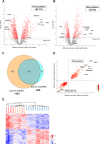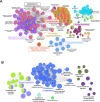In-Depth Serum Proteomics by DIA-MS with In Silico Spectral Libraries Reveals Dynamics during the Active Phase of Systemic Juvenile Idiopathic Arthritis
- PMID: 35252692
- PMCID: PMC8892657
- DOI: 10.1021/acsomega.1c06681
In-Depth Serum Proteomics by DIA-MS with In Silico Spectral Libraries Reveals Dynamics during the Active Phase of Systemic Juvenile Idiopathic Arthritis
Abstract
In serum proteomics using mass spectrometry, the number of detectable proteins is reduced due to high-abundance proteins, such as albumin. However, recently developed data-independent acquisition mass spectrometry (DIA-MS) proteomics technology has made it possible to remarkably improve the number of proteins in a serum analysis by removing high-abundance proteins. Using this technology, we analyzed sera from patients with systemic juvenile idiopathic arthritis (sJIA), a rare pediatric disease. As a result, we identified 2727 proteins with a wide dynamic range derived from various tissue leakages. We also selected 591 proteins that differed significantly in their active phases. These proteins were involved in many inflammatory processes, and we also identified immunoproteasomes, which were not previously found in serum, suggesting that they may be involved in the pathogenesis of sJIA. A detailed high-depth DIA-MS proteomic analysis of serum may be useful for understanding the pathogenesis of sJIA and may provide clues for the development of new biomarkers.
© 2022 The Authors. Published by American Chemical Society.
Conflict of interest statement
The authors declare no competing financial interest.
Figures




References
-
- Nieto-Fontarigo J. J.; Gonzalez-Barcala F. J.; Andrade-Bulos L. J.; San-Jose M. E.; Cruz M. J.; Valdes-Cuadrado L.; Crujeiras R. M.; Arias P.; Salgado F. J. iTRAQ-based proteomic analysis reveals potential serum biomarkers of allergic and nonallergic asthma. Allergy 2020, 75, 3171–3183. 10.1111/all.14406. - DOI - PubMed
-
- Kimura Y.; Yanagimachi M.; Ino Y.; Aketagawa M.; Matsuo M.; Okayama A.; Shimizu H.; Oba K.; Morioka I.; Imagawa T.; Kaneko T.; Yokota S.; Hirano H.; Mori M. Identification of candidate diagnostic serum biomarkers for Kawasaki disease using proteomic analysis. Sci. Rep. 2017, 7, 43732 10.1038/srep43732. - DOI - PMC - PubMed
-
- Duangkumpha K.; Stoll T.; Phetcharaburanin J.; Yongvanit P.; Thanan R.; Techasen A.; Namwat N.; Khuntikeo N.; Chamadol N.; Roytrakul S.; Mulvenna J.; Mohamed A.; Shah A. K.; Hill M. M.; Loilome W. Discovery and Qualification of Serum Protein Biomarker Candidates for Cholangiocarcinoma Diagnosis. J. Proteome Res. 2019, 18, 3305–3316. 10.1021/acs.jproteome.9b00242. - DOI - PubMed
LinkOut - more resources
Full Text Sources
Research Materials

